AP Physics B Exam
11 Electric Potential and Capacitance
INTRODUCTION
When an object moves in a gravitational field, it usually experiences a change in kinetic energy and in gravitational potential energy due to the work done on the object by gravity. Similarly, when a charge moves in an electric field, it generally experiences a change in kinetic energy and in electrical potential energy due to the work done on it by the electric field. By exploring the idea of electric potential, we can simplify our calculations of work and energy changes within electric fields.
ELECTRICAL POTENTIAL ENERGY
When a charge moves in an electric field, then unless its displacement is always perpendicular to the field, the electric force does work on the charge. If WE is the work done by the electric force, then the change in the charge”s electrical potential energy is defined by
∆UE = –WE
Notice that this is the same equation that defined the change in the gravitational potential energy of an object of mass m undergoing a displacement in a gravitational field (∆UG = –WG).
Example 11.1 A positive charge +q moves from position A to position B in a uniform electric field E:
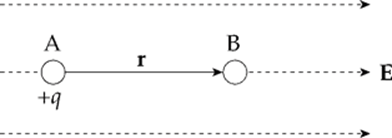
What is its change in electrical potential energy?
Solution. Since the field is uniform, the electric force that the charge feels, FE = qE, is constant. Since q is positive, FE points in the same direction as E, and, as the figure shows, they point in the same direction as the displacement, r. This makes the work done by the electric field equal toWE = FEr = qEr, so the change in the electrical potential energy is
∆UE = –qEr
Note that the change in potential energy is negative, which means that potential energy has decreased; this always happens when the field does positive work. It”s just like dropping a rock to the ground: Gravity does positive work, and the rock loses gravitational potential energy.
Example 11.2 Do the previous problem, but consider the case of a negative charge, –q.
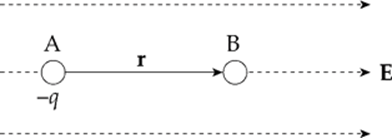
Solution. In this case, an outside agent must be pushing the charge to make it move, because the electric force naturally pushes negative charges against field lines. Therefore, we expect that the work done by the electric field is negative. The electric force, FE = (–q)E, points in the direction opposite to the displacement, so the work it does is WE = –FEr = –qEr = –qEr. Thus, the change in electrical potential energy is positive: ∆UE = –WE = –(–qEr) = qEr. Because the change in potential energy is positive, the potential energy increases; this always happens when the field does negative work. It”s like lifting a rock off the ground: Gravity does negative work, and the rock gains gravitational potential energy.
Example 11.3 A positive charge +q moves from position A to position B in a uniform electric field E:
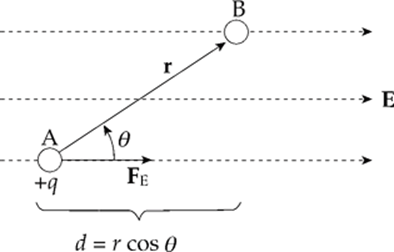
What is its change in electrical potential energy?
Solution. The electric force felt by the charge q is FE = qE and this force is parallel to E, because q is positive. In this case, because FE is not parallel to r (as it was in Example 11.1), we will use the more general definition of work:
WE = FE · r = FE r cos θ = qEr cos θ
But r cos θ = d, so
WE = qEd and ∆UE = –WE = –qEd
Because the electric force is a conservative force, which means that the work done does not depend on the path that connects the positions A and B, the work calculated above could have been figured out by considering the path from A to B composed of the segments r1 and r2:

Along r1, the electric force does no work since this displacement is perpendicular to the force. Thus, the work done by the electric field as q moves from A to B is simply equal to the work it does along r2. And since the length of r2 is d = r cos θ, we have WE = FEd = qEd, just as before.
Example 11.4 A positive charge q1 = +2 × 10–6 C is held stationary, while a negative charge, q2 = –1 × 10–8 C, is released from rest at a distance of 10 cm from q1. Find the kinetic energy of charge q2 when it”s 1 cm from q1.
Solution. The gain in kinetic energy is equal to the loss in potential energy; you know this from Conservation of Energy. Electrical potential energy is given by  . Therefore, if q1 is fixed and q2 moves from rA to rB, the change in potential energy is
. Therefore, if q1 is fixed and q2 moves from rA to rB, the change in potential energy is

So the gain in kinetic energy is +0.016 J. Since q2 started from rest (with no kinetic energy), this is the kinetic energy of q2 when it”s 1 cm from q1.
Example 11.5 Two positive charges, q1 and q2, are held in the positions shown below. How much work would be required to bring (from infinity) a third positive charge, q3, and place it so that the three charges form the corners of an equilateral triangle of side length s?
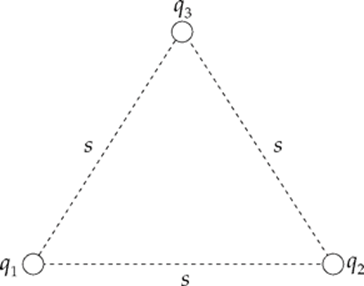
Solution. An external agent would need to do positive work, equal in magnitude to the negative work done by the electric force on q3 as it is brought into place, so let”s first compute this quantity. Let”s first compute the work done by the electric force as q3 is brought in. Since q3 is fighting against both q1”s and q2”s electric field, the total work done on q3 by the electric force, WE, is equal to the work done on q3 by q1 (W1–3) plus the work done on q3 by q2 (W2–3). Using the equation WE = –∆UE and the one we gave above for ∆UE, we have

Therefore, the work that an external agent must do to bring q3 into position is

In general, the work required by an external agent to assemble a collection of point charges q1, q2,…, qn (bringing each one from infinity), such that the final fixed distance between qi and qj is rij, is equal to the total electrical potential energy of the arrangement:

ELECTRIC POTENTIAL
Let WE be the work done by the electric field on a charge q as it undergoes a displacement. If another charge, say 2q, were to undergo the same displacement, the electric force would be twice as great on this second charge, and the work done by the electric field would be twice as much, 2WE. Since the work would be twice as much in the second case, the change in electrical potential energy would be twice as great as well, but the ratio of the change in potential energy to the charge would be the same: UE/q = UE/2q. This ratio says something about the field and thedisplacement but not the charge that made the move. The change in electric potential ∆V, is defined as this ratio:

Electric potential is electrical potential energy per unit charge; the units of electric potential are joules per coulomb. One joule per coulomb is called one volt (abbreviated V); so 1 J/C = 1 V.
Consider the electric field that”s created by a point source charge Q. If a charge q moves from a distance rA to a distance rB from Q, then the change in the potential energy is

The difference in electric potential between positions A and B in the field created by Q is

If we designate VA → 0 as rA → ∞ (an assumption that”s stated on the AP Physics Exam), then the electric potential at a distance r from Q is

Note that the potential depends on the source charge making the field and the distance from it.
Example 11.6 Let Q = 2 × 10–9 C. What is the potential at a Point P that is 2 cm from Q?
Solution. Relative to V = 0 at infinity, we have

This means that the work done by the electric field on a charge of q coulombs brought to a point 2 cm from Q would be –900q joules.
Note that, like potential energy, electric potential is a scalar. In the preceding example, we didn”t have to specify the direction of the vector from the position of Q to the Point P, because it didn”t matter. At any point on a sphere that”s 2 cm from Q, the potential will be 900 V. These spheres around Q are called equipotential surfaces, and they”re surfaces of constant potential. Their cross sections in any plane are circles and are (therefore) perpendicular to the electric field lines. The equipotentials are always perpendicular to the electric field line.
Example 11.7 How much work is done by the electric field as a charge moves along an equipotential surface?
Solution. If the charge always remains on a single equipotential, then, by definition, the potential, V, never changes. Therefore, ∆V = 0, so ∆UE = 0. Since WE = – ∆UE, the work done by the electric field is zero.
Example 11.8 If charges q1 = 4 × 10–9 C and q2 = –6 × 10–9 C are stationary, calculate the potential at Point A in the figure below:
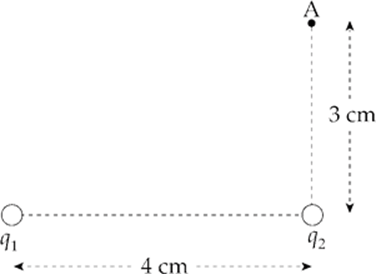
Solution. Potentials add like ordinary numbers. Therefore, the potential at A is just the sum of the potentials at A due to q1 and q2. Note that the distance from q1 to A is 5 cm.

Example 11.9 How much work would it take to move a charge q = +1 × 10–2 C from Point A to Point B (the point midway between q1 and q2?
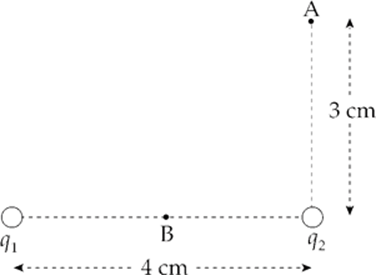
Solution. ∆UE = q∆V, so if we calculate the potential difference between Points A and B and multiply by q, we will have found the change in the electrical potential energy: ΔUA→B = qΔVA→B. Then, since the work by the electric field is –∆U, the work required by an external agent is ∆U. In this case, the potential at Point B is

In the preceding example, we calculated the potential at Point A: VA = –1080 V, so ∆VA → B = VB – VA = (–900 V) – (–1080 V) = +180 V. This means that the change in electrical potential energy as q moves from A to B s
ΔUA→B = qVA→B = (+1 × 10–2 C)(+180 V) = 1.8 J
This is the work required by an external agent to move q from A to B.
THE POTENTIAL IN A UNIFORM FIELD
Example 11.10 Consider a very large, flat plate that contains a uniform surface charge density σ. At points that are not too far from the plate, the electric field is uniform and given by the equation

What is the potential at a point which is a distance d from the sheet, relative to the potential of the sheet itself?
Solution. Let A be a point on the plate and let B be a point a distance d from the sheet. Then

Since the field is constant, the force that a charge q would feel is also constant, and is equal to

Therefore,

so applying the definition gives us

This says that the potential decreases linearly as we move away from the plate.
Example 11.11 Two large flat plates—one carrying a charge of +Q, the other –Q—are separated by a distance d. The electric field between the plates, E, is uniform. Determine the potential difference between the plates.
Solution. Imagine a positive charge q moving from the positive plate to the negative plate:

Since the work done by the electric field is
WE,+→– = FEd = qEd
the potential difference between the plates is

This tells us that the potential of the positive plate is greater than the potential of the negative plate, by the amount Ed. This equation can also be written as

Therefore, if the potential difference and the distance between the plates are known, then the magnitude of the electric field can be determined quickly.
CAPACITANCE
Consider two conductors, separated by some distance, that carry equal but opposite charges, +Q and –Q. Such a pair of conductors comprise a system called a capacitor. Work must be done to create this separation of charge, and, as a result, potential energy is stored. Capacitors are basically storage devices for electrical potential energy.
The conductors may have any shape, but the most common conductors are parallel metal plates or sheets. These types of capacitors are called parallel-plate capacitors. We”ll assume that the distance d between the plates is small compared to the dimensions of the plates since, in this case, the electric field between the plates is uniform. The electric field due to one such plate, if its surface charge density is σ = Q/A, is given by the equation E = σ/(2ε0), with E pointing away from the sheet if σ is positive and toward the plate if σ is negative.

Therefore, with two plates, one with surface charge density +σ and the other –σ, the electric fields combine to give a field that”s zero outside the plates and that has the magnitude

in between. In Example 11.11, we learned that the magnitude of the potential difference, ∆V, between the plates satisfies the relationship ∆V = Ed, so combining this with the previous equation, we get

The ratio of Q to ∆V, for any capacitor, is called its capacitance (C),
C = Q/∆V
so for a parallel-plate capacitor, we get

The capacitance measures the capacity for holding charge. The greater the capacitance, the more charge can be stored on the plates at a given potential difference. The capacitance of any capacitor depends only on the size, shape, and separation of the conductors. From the definition, C =Q/∆V, the units of C are coulombs per volt. One coulomb per volt is renamed one farad (abbreviated F): 1 C/V = 1 F.
Example 11.12 A 10-nanofarad parallel-plate capacitor holds a charge of magnitude 50 μC on each plate.
(a) What is the potential difference between the plates?
(b) If the plates are separated by a distance of 0.2 mm, what is the area of each plate?
Solution.
(a) From the definition, C = Q/∆V, we find that

(b) From the equation C = ε0A/d, we can calculate the area, A, of each plate:

COMBINATIONS OF CAPACITORS
Capacitors are often arranged in combination in electric circuits. Here we”ll look at two types of arrangements, the parallel combination and the series combination.
A collection of capacitors are said to be in parallel if they all share the same potential difference. The following diagram shows two capacitors wired in parallel:

The top plates are connected by a wire and form a single equipotential; the same is true for the bottom plates. Therefore, the potential difference across one capacitor is the same as the potential difference across the other capacitor.
We want to find the capacitance of a single capacitor that would perform the same function as this combination. If the capacitances are C1 and C2, then the charge on the first capacitor is Q1 = C1∆V and the charge on the second capacitor is Q2 = C2∆V. The total charge on the combination is Q1 + Q2, so the equivalent capacitance, CP, must be

So the equivalent capacitance of a collection of capacitors in parallel is found by adding the individual capacitances.
A collection of capacitors are said to be in series if they all share the same charge magnitude. The following diagram shows two capacitors wired in series:

When a potential difference is applied, as shown, negative charge will be deposited on the bottom plate of the bottom capacitor; this will push an equal amount of negative charge away from the top plate of the bottom capacitor toward the bottom plate of the top capacitor. When the system has reached equilibrium, the charges on all the plates will have the same magnitude:

If the top and bottom capacitors have capacitances of C1 and C2, respectively, then the potential difference across the top capacitor is ∆V1 = Q/C1, and the potential difference across the bottom capacitor is ∆V2 = Q/C2. The total potential difference across the combination is ∆V1 + ∆V1, which must equal ∆V. Therefore, the equivalent capacitance, CS, must be

We can write this in another form:

In words, the reciprocal of the capacitance of a collection of capacitors in series is found by adding the reciprocals of the individual capacitances.
Example 11.13 Given that C1 = 2 µF, C2 = 4 µF, an C3 = 6 µF, calculate the equivalent capacitance for the following combination:
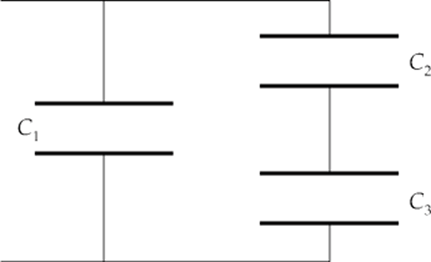
Solution. Notice that C2 and C3 are in series, and they are in parallel with C1. That is, the capacitor equivalent to the series combination of C2 and C3 (which we”ll call C2-3) is in parallel with C1. We can represent this as follows:

So, the first step is to find C2-3:

Now this is in parallel with C1, so the overall equivalent capacitance (C1-2-3) is

Substituting in the given numerical values, we get

THE ENERGY STORED IN A CAPACITOR
To figure out the electrical potential energy stored in a capacitor, imagine taking a small amount of negative charge off the positive plate and transferring it to the negative plate. This requires that positive work is done by an external agent, and this is the reason that the capacitor stores energy. If the final charge on the capacitor is Q, then we transferred an amount of charge equal to Q, fighting against the prevailing voltage at each stage. If the final voltage is ∆V, then the average voltage during the charging process is ![]() ∆V; so, because ∆UE is equal to charge times voltage, we can write ΔUE = Q ·
∆V; so, because ∆UE is equal to charge times voltage, we can write ΔUE = Q · ![]() ΔV =
ΔV = ![]() QΔV. At the beginning of the charging process, when there was no charge on the capacitor, we had Ui = 0, so ∆UE = Uf – Ui = Uf – 0 = Uf; therefore, we have
QΔV. At the beginning of the charging process, when there was no charge on the capacitor, we had Ui = 0, so ∆UE = Uf – Ui = Uf – 0 = Uf; therefore, we have

This is the electrical potential energy stored in a capacitor. Because of the definition C = Q/ΔV, the equation for the stored potential energy can be written in two other forms:

CHAPTER 11 REVIEW QUESTIONS
Solutions can be found in Chapter 18.
SECTION I: MULTIPLE CHOICE
1. Which of the following statements is/are true?
I. If the electric field at a certain point is zero, then the electric potential at the same point is also zero.
II. If the electric potential at a certain point is zero, then the electric field at the same point is also zero.
III. The electric potential is inversely proportional to the strength of the electric field.
(A) I only
(B) II only
(C) I and II only
(D) I and III only
(E) None are true
2. If the electric field does negative work on a negative charge as the charge undergoes a displacement from Position A to Position B within an electric field, then the electrical potential energy
(A) is negative
(B) is positive
(C) increases
(D) decreases
(E) Cannot be determined from the information given
3.

The work required to assemble the system shown above, bringing each charge in from an infinite distance, is equal to
(A) 
(B) 
(C) 
(D) 
(E) 
4. Negative charges are accelerated by electric fields toward points
(A) at lower electric potential
(B) at higher electric potential
(C) where the electric field is zero
(D) where the electric field is weaker
(E) where the electric field is stronger
5. A charge q experiences a displacement within an electric field from Position A to Position B. The change in the electrical potential energy is ∆UE, and the work done by the electric field during this displacement is WE. Then
(A) VB – VA = WE/q
(B) VA – VB = qWE
(C) VB – VA = qWE
(D) VA – VB = ∆UE/q
(E) VB – VA = ∆UE/q
6.

Which points in this uniform electric field (between the plates of the capacitor) shown above lie on the same equipotential?
(A) 1 and 2 only
(B) 1 and 3 only
(C) 2 and 4 only
(D) 3 and 4 only
(E) 1, 2, 3, and 4 all lie on the same equipotential since the electric field is uniform.
7.
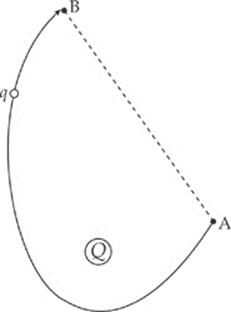
How much work would the electric field (created by the stationary charge Q) perform as a charge q is moved from Point A to B along the curved path shown?
VA = 200 V, VB = 100 V, q = –0.05 C, length of line segment AB = 10 cm, length of curved path = 20 cm.
(A) –10 J
(B) –5 J
(C) +5 J
(D) +10 J
(E) +2 J
8.

If each of the capacitors in the array shown above is C, what is the capacitance of the entire combination?
(A) C/2
(B) 2C/3
(C) 5C/6
(D) 2C
(E) 5C/3
SECTION II: FREE RESPONSE
1. In the figure shown, all four charges are situated at the corners of a square with sides s.
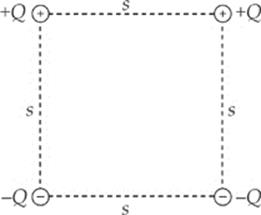
(a) What is the total electrical potential energy of this array of fixed charges?
(b) What is the electric field at the center of the square?
(c) What is the electric potential at the center of the square?
(d) Sketch (on the diagram) the portion of the equipotential surface that lies in the plane of the figure and passes through the center of the square.
(e) How much work would the electric field perform on a charge q as it moved from the midpoint of the right side of the square to the midpoint of the top of the square?
2. The figure below shows a parallel-plate capacitor. Each rectangular plate has length L and width w, and the plates are separated by a distance d.

(a) Determine the capacitance.
An electron (mass m, charge –e) is shot horizontally into the empty space between the plates, midway between them, with an initial velocity of magnitude v0. The electron just barely misses hitting the end of the top plate as it exits. (Ignore gravity.)

(b) In the diagram, sketch the electric field vector at the position of the electron when it has traveled a horizontal distance of L/2.
(c) In the diagram, sketch the electric force vector on the electron at the same position as in part (b).
(d) Determine the strength of the electric field between the plates. Write your answer in terms of L, d, m, e, and v0.
(e) Determine the charge on the top plate.
(f) How much potential energy is stored in the capacitor?
3. A solid conducting sphere of radius a carries an excess charge of Q.
(a) Determine the electric field magnitude, E(r), as a function of r, the distance from the sphere”s center.
(b) Determine the potential, V(r), as a function of r. Take the zero of potential at r = ∞.
(c) On the diagrams below, sketch E(r) and V(r). (Cover at least the range 0 < r < 2a.)
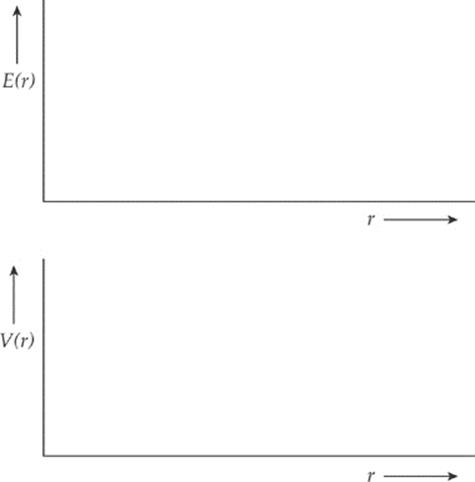
SUMMARY
· The electric potential (commonly referred to as the voltage) is defined as V = ![]() .
.
· The electrical potential energy is defined by

· The work done moving a charge through an electric field is given by W = qEd.
· A capacitor is basically a storage device for electrical potential energy. Capacitance is given by C = ![]() . For parallel plate capacitors, we have C =
. For parallel plate capacitors, we have C = ![]() where ε0 = 8.85 × 10–12 C2/Nm2, A is the area of the plate and d is the distance between the plates.
where ε0 = 8.85 × 10–12 C2/Nm2, A is the area of the plate and d is the distance between the plates.
· To find the combined capacitance of capacitors in parallel (side by side), simply add their capacitances
![]()
· To find the capacitance of capacitors in series (one after another), add their inverses:

· The electrical energy stored in a capacitor is given by either
